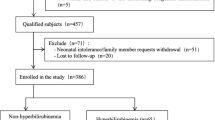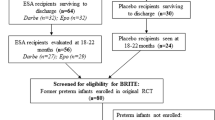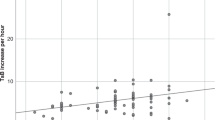Abstract
The objective of the present study was to determine whether whole blood carboxyhemoglobin (COHb) and plasma bilirubin, two indicators of hemolysis, are elevated in infants with severe Rh isoimmune hemolytic disease during the first months of life. Beginning at 2 wk of age and continuing monthly for 3 mo, serial blood samples were obtained for COHb, plasma bilirubin, Hb, reticulocyte count, plasma erythropoietin, plasma enzymes, and plasma iron. Because control infants (n = 13) and infants with ABO hemolytic disease (n = 5) did not differ from one another in any of the study parameters, these two groups were combined and compared with infants with the Rh isoimmunization. Infants with severe Rh isoimmune hemolytic disease(n = 13) were found to have significantly lower Hb and significantly higher bilirubin, the COHb fraction divided by the Hb concentration(COHb√Hb), and plasma erythropoietin levels at 2 and 6 wk of age, and reticulocyte counts at 6 wk. The remaining parameters were not different between the control-ABO group and Rhisoimmune group at any of the study intervals. The study's two primary indicators of hemolysis, plasma bilirubin and COHb√Hb, were significantly correlated with one another in the Rh-immunized group (r = 0.66, p < 0.0001), but not in the combined control-ABO group. Serial Rh antibody concentrations measured in the serum of four neonates with Rh isoimmunization demonstrated a mean half-life of 14.3 d. We speculate that, among infants with severe Rh isoimmune hemolytic disease, elevated total bilirubin levels and COHb√Hb ratios identified in the early weeks of life indicate continuing hemolysis due to persistence of maternal Rh antibodies.
Similar content being viewed by others
Log in or create a free account to read this content
Gain free access to this article, as well as selected content from this journal and more on nature.com
or
Abbreviations
- CO:
-
carbon monoxide
- COHb:
-
carboxyhemoglobin
- COHb√Hb:
-
carboxyhemoglobin fraction divided by Hb concentration
- Epo:
-
erythropoietin
- RBC:
-
red blood cell
- Rh:
-
rhesus
- ANOVA:
-
analysis of variance
References
Weiner CP 1994 Fetal hemolytic disease. In: James DK, Steer PJ, Weiner CP, Gonik B (eds) High Risk Pregnancy: Management Options. WB Saunders, London, pp 783–801
Coburn RF, Williams WJ, White P, Kahn SB 1967 The production of carbon monoxide from hemoglobin in vivo. J Clin Invest 46: 346–356
Tenhunen R, Marver HS, Schmid R 1968 The enzymatic conversion of heme to bilirubin by microsomal heme oxygenase. Proc Natl Acad Sci USA 61: 748–755
Berk PD, Blaschke TF, Scharschmidt BF, Waggoner JG, Berlin NI 1976 A new approach to quantitation of the various sources of bilirubin in man. J Lab Clin Med 87: 767–780
Ergaz Z, Gross D, Bar-Oz B, Arad I 1995 Carboxyhemglobin levels in neonatal jaundice treated with intravenous gammaglobulin. Vox Sang 69: 95–99
Fällström SP, Bjure J 1967 Endogenous formation of carbon monoxide in newborn infants. Acta Paediatr Scand 56: 365–373
Wranne L 1969 Studies on erythro-kinetics in infancy. XIV. The relation between anaemia and haemoglobin catabolism in Rh-haemolytic disease of the newborn. Acta Paediatr Scand 58: 49–53
Uetani Y, Nakamura J, Okamoto O, Yamazaki T, Vreman HJ, Stevenson DK 1989 Carboxyhemoglobin measurements in the diagnosis of ABO hemolytic disease. Acta Paediatr Jpn 31: 171–176
Maisels MJ 1994 Jaundice. In: Avery GB, Fletcher MA, Macdonald MG (eds) Neonatology: Pathophysiology and Management of the Newborn. JB Lippincott, Philadelphia, pp 630–725
Widness JA, Lowe LS, Stevenson DK, Vreman HJ, Weiner CP, Hayde M, Pollak A 1994 Direct relationship of fetal carboxyhemoglobin with hemolysis in alloimmunized pregnancies. Pediatr Res 35: 713–719
Zipursky A, Bowman JM 1993 Isoimmune hemolytic disease. In: Nathan R, Oski F (eds) Hematology of Infancy and Childhood. WB Saunders, Philadelphia, pp 44–73
Bowman JM 1989 Hemolytic disease (erythroblastosis fetalis). In: Creasy R, Resnik R (eds) Maternal-Fetal Medicine. WB Saunders, Philadelphia, pp 613–655
Georgieff MK, Landon MB, Mills MM, Hedlund BE, Faassen AE, Schmidt RL, Ophoven JJ, Widness JA 1990 Abnormal iron distribution in infants of diabetic mothers: spectrum and maternal antecedents. J Pediatr 117: 455–461
Vreman HJ, Kwong LK, Stevenson DK 1984 Carbon monoxide in blood: an improved microliter blood-sample collection system, with rapid analysis by gas chromatography. Clin Chem 30: 1382–1386
Vreman HJ, Stevenson DK, Zwart A 1987 Analysis for carboxyhemoglobin by gas chromatography and multicomponent spectrophotometry compared. Clin Chem 33: 694–697
Eilers RJ 1967 Notification of final adoption of an international method and standard solution for hemoglobinometry specifications for preparation of standard solutions. Am J Clin Pathol 47: 212–214
Bowman JM, Pollock JM, Biggins KR 1988 Antenatal studies and management of hemolytic disease of the neoborn. In: Greenwalt TJ(ed) Hematology: Blood Transfusion. Churchill Livingstone, New York, pp 163–212
Vreman HJ, Mahoney JJ, Stevenson DK 1995 Carbon monoxide and carboxyhemoglobin. Adv Pediatr 42: 303–334
Cohen RS, Durand DJ, Stevenson DK 1986 Serum bilirubin levels in very low birth weight infants during the first two months of life. J Perinatol 6: 259–261
Bowman JM, Pollock JM 1987 Failures of intravenous Rh immune globulin prophylaxis: an analysis of the reasons for such failures. Transfus Med Rev 1: 101–112
Maisels MJ, Pathak A, Nelson NM, Nathan DG, Smith CL 1971 Endogenous production of carbon monoxide in normal and erythroblastotic newborn infants. J Clin Invest 50: 1–8
Fällström SP, Bjure J 1968 Endogenous formation of carbon monoxide in newborn infants. III. ABO incompatibility. Acta Paediatr Scand 57: 137–144
Hyman CB, Sturgeon P 1955 Observations on the convalescent phase of erythroblastosis fetalis. Pediatrics 16: 15–23
Millard DD, Gidding SS, Socol ML, MacGregor SN, Dooley SL, Ney JA, Stockman JA 1990 Effects of intravascular, intrauterine transfusions on prenatal and postnatal hemolysis and erythropoiesis in severe fetal isoimmunization. J Pediatr 117: 447–454
Ebbesen F 1979 Late anemia in infants with rhesus haemolytic disease treated with intensive phototherapy. Eur J Pediatr 130: 285–290
Giblett ER, Varela JE, Finch CA 1956 Damage of the bone marrow due to Rh antibody. Pediatrics 17: 37–44
Acknowledgements
The authors express their appreciation to Mark Hart and G. Hatlauf for secretarial assistance, Birgit Panzenböck and Robert Schmidt for laboratory assistance, to Maria Babich for chart review and interaction with families, to Dr. Leon Burmeister for statistical advice, and to Dr. John M. Bowmann and Janet Pollock of the Rh Laboratory, Health Science Centre, Winnipeg, Canada, for the Rh antibody measurements.
Author information
Authors and Affiliations
Additional information
Supported in part by National Institutes of Health Grants HD14426, RR00070, and HL46925, and by The Mary L. Johnson Research Fund.
Rights and permissions
About this article
Cite this article
Hayde, M., Widness, J., Pollak, A. et al. Rhesus Isoimmunization: Increased Hemolysis during Early Infancy. Pediatr Res 41, 716–721 (1997). https://doi.org/10.1203/00006450-199705000-00018
Received:
Accepted:
Issue date:
DOI: https://doi.org/10.1203/00006450-199705000-00018
This article is cited by
-
Jack Widness: the importance of connections
Pediatric Research (2018)
-
Effect of Hematocrit on Exhaled Carbon Monoxide in Healthy Newborn Infants
Journal of Perinatology (2005)



